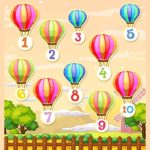Geography is an amazing subject that opens up the world to young and old minds alike. It is fascinating to explore different cultures, landscapes, and people from across the globe. Understanding the list of countries and their capitals is a fundamental aspect of geography. It enhances a child’s knowledge about the different countries around us. It also helps in instilling a sense of curiosity about the diverse world that we live in. Learning about the important countries and their capitals reflects a broader understanding of global affairs. In this article, we will take a delightful journey through the complete list of names of countries and their capitals, with tips to make learning all the names of countries and their capitals an enjoyable experience for kids.
The word ‘capital’ comes from the Latin word caput, which means ‘head.’ Each country has a capital that acts as the head of the state. Some countries have more than one capital.
Below is the complete list of countries and their capitals in alphabetical order. There are 195 officially recognised countries in the entire world.
Countries and their Capitals
Afghanistan – Kabul Albania – Tirana Algeria – Algiers Andorra – Andorra la Vella Angola – Luanda Antigua and Barbuda – St. John’s Argentina – Buenos Aires Armenia – Yerevan Australia – Canberra Austria – Vienna Azerbaijan – Baku Bahamas – Nassau Bahrain – Manama Bangladesh – Dhaka Barbados – Bridgetown Belarus – Minsk Belgium – Brussels Belize – Belmopan Benin – Porto-Novo Bhutan – Thimphu Bolivia – Sucre (constitutional) / La Paz (seat of government) Bosnia and Herzegovina – Sarajevo Botswana – Gaborone Brazil – Brasília Brunei – Bandar Seri Begawan Bulgaria – Sofia Burkina Faso – Ouagadougou Burundi – Bujumbura Cabo Verde – Praia Cambodia – Phnom Penh Cameroon – Yaoundé Canada – Ottawa Central African Republic – Bangui Chad – N’Djamena Chile – Santiago China – Beijing Colombia – Bogotá Comoros – Moroni Congo (Congo-Brazzaville) – Brazzaville Costa Rica – San José Croatia – Zagreb Cuba – Havana Cyprus – Nicosia Czech Republic – Prague Democratic Republic of the Congo (Congo-Kinshasa) – Kinshasa Denmark – Copenhagen Djibouti – Djibouti Dominica – Roseau Dominican Republic – Santo Domingo East Timor (Timor-Leste) – Dili Ecuador – Quito Egypt – Cairo El Salvador – San Salvador Equatorial Guinea – Malabo Eritrea – Asmara Estonia – Tallinn Eswatini – Mbabane (administrative) / Lobamba (legislative) Ethiopia – Addis Ababa Fiji – Suva Finland – Helsinki France – Paris Gabon – Libreville Gambia – Banjul Georgia – Tbilisi Germany – Berlin Ghana – Accra Greece – Athens Grenada – St. George’s Guatemala – Guatemala City Guinea – Conakry Guinea-Bissau – Bissau Guyana – Georgetown Haiti – Port-au-Prince Honduras – Tegucigalpa Hungary – Budapest Iceland – Reykjavik India – New Delhi Indonesia – Jakarta Iran – Tehran Iraq – Baghdad Ireland – Dublin Israel – Jerusalem Italy – Rome Ivory Coast – Yamoussoukro (official) / Abidjan (administrative) Jamaica – Kingston Japan – Tokyo Jordan – Amman Kazakhstan – Nur-Sultan Kenya – Nairobi Kiribati – South Tarawa Korea, North – Pyongyang Korea, South – Seoul Kosovo – Pristina Kuwait – Kuwait City Kyrgyzstan – Bishkek Laos – Vientiane Latvia – Riga Lebanon – Beirut Lesotho – Maseru Liberia – Monrovia Libya – Tripoli Liechtenstein – Vaduz Lithuania – Vilnius Luxembourg – Luxembourg City Madagascar – Antananarivo Malawi – Lilongwe Malaysia – Kuala Lumpur Maldives – Malé Mali – Bamako Malta – Valletta Marshall Islands – Majuro Mauritania – Nouakchott Mauritius – Port Louis Mexico – Mexico City Micronesia – Palikir Moldova – Chisinau Monaco – Monaco Mongolia – Ulaanbaatar Montenegro – Podgorica Morocco – Rabat Mozambique – Maputo Myanmar (Burma) – Naypyidaw Namibia – Windhoek Nauru – Yaren Nepal – Kathmandu Netherlands – Amsterdam New Zealand – Wellington Nicaragua – Managua Niger – Niamey Nigeria – Abuja North Macedonia – Skopje Norway – Oslo Oman – Muscat Pakistan – Islamabad Palau – Ngerulmud Panama – Panama City Papua New Guinea – Port Moresby Paraguay – Asunción Peru – Lima Philippines – Manila Poland – Warsaw Portugal – Lisbon Qatar – Doha Romania – Bucharest Russia – Moscow Rwanda – Kigali Saint Kitts and Nevis – Basseterre Saint Lucia – Castries Saint Vincent and the Grenadines – Kingstown Samoa – Apia San Marino – San Marino Sao Tome and Principe – Sao Tome Saudi Arabia – Riyadh Senegal – Dakar Serbia – Belgrade Seychelles – Victoria Sierra Leone – Freetown Singapore – Singapore Slovakia – Bratislava Slovenia – Ljubljana Solomon Islands – Honiara Somalia – Mogadishu South Africa – Pretoria (administrative) / Bloemfontein (judicial) / Cape Town (legislative) South Sudan – Juba Spain – Madrid Sri Lanka – Colombo (executive) / Sri Jayawardenepura Kotte (legislative) Sudan – Khartoum Suriname – Paramaribo Sweden – Stockholm Switzerland – Bern Syria – Damascus Taiwan – Taipei Tajikistan – Dushanbe Tanzania – Dodoma (official) / Dar es Salaam (administrative) Thailand – Bangkok Togo – Lome Tonga – Nuku’alofa Trinidad and Tobago – Port of Spain Tunisia – Tunis Turkey – Ankara Turkmenistan – Ashgabat Tuvalu – Funafuti Uganda – Kampala Ukraine – Kyiv United Arab Emirates – Abu Dhabi United Kingdom – London United States – Washington, D.C. Uruguay – Montevideo Uzbekistan – Tashkent Vanuatu – Port Vila Vatican City – Vatican City Venezuela – Caracas Vietnam – Hanoi Yemen – Sana’a Zambia – Lusaka Zimbabwe – Harare Please note that Taiwan is included in this list, although its political status is a subject of international debate. Now that we have looked at all the important countries and their capitals, let us delve into the concept of continents.
What are Continents?
Continents are large, continuous landmasses that make up the earth’s surface. Countries are a part of these continents. There are seven continents on earth.
- Asia:
- Africa:
- North America:
- South America:
- Antarctica:
- Europe:
- Australia:
The largest continent, covering a significant portion of the eastern and northern hemispheres. Asia has the most population in the world, led by the countries India and China.
The second-largest continent, located to the south of Europe and southwest of Asia. This continent has the maximum number of countries.
Comprising Canada, the United States, Mexico, and other famous countries and their capitals in the northern part of the American continent.
Located in the western hemisphere, it is the continent to the south of North America.
The southernmost continent, predominantly covered by ice and surrounded by the Southern Ocean. There is no permanent population in this continent, although there are research stations.
Situated to the west of Asia, it is the second smallest continent in terms of land area.
Often referred to as a continent and a country, it is located in the southern hemisphere. In terms of land area, Australia is the smallest continent in the world.
Fact Check: Is Oceania a Continent?
Oceania is not considered a continent in terms of the geographical definition of a continent. However, when dividing the world into 7 regions which are the continents, the islands of the Pacific are usually grouped with Australia and called Oceania. Sometimes these regions are called continents even though it is technically incorrect.
Activities to Engage your Kids to Learn About Famous Countries and their Capitals
Teaching kids about famous countries and their capitals can be entertaining and educational. We present to you several activities that will help enrich their knowledge on the geography of the world in a fun manner.
- World Map Puzzle
- Interactive Globes
- Country Flashcards
- Geography Bee
- Cooking Around the World
Use a world map puzzle and allow your kids to put the world map puzzle together. As they assemble the pieces together, discuss the names of countries and their capitals.
Provide an interactive globe that lights up or speaks when it is touched. Kids can explore different countries and their capitals by spinning the interactive globe and stopping it with their finger.
Create a set of flashcards with the name of a country on one side and its capital on the other side. Use these cards to conduct quiz games, or simply to familiarise the kids with the list of countries and their capitals.
Organise a mini Geography Bee at home with the kids and their friends. Ask them questions about the important countries and their capitals. Reward correct answers with small prizes.
Explore the cuisines of different countries. Choose a country, find a simple recipe online, and cook a traditional dish together. While enjoying the meal, discuss the country and its capital.
Learning the countries and capitals can open up the world to young minds and provide them a sense of global awareness. As children embark on this adventure, they not only memorise names on a map but also gain a deeper understanding of the people, cultures, and histories that make our world so wonderfully diverse. Let us encourage our young explorers to grab their maps and embark on a journey of discovery!
For more of such interesting blogs, visit EuroKids.















